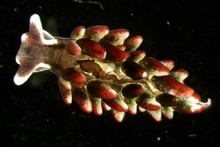By Geoff Cumming, NZ Herald Saturday Aug 7, 2010
The good news from the first Census of Marine Life is: New Zealand's waters are indeed teeming with wondrous creatures and plants; we are a hotspot for biodiversity in many respects.
Our seas are home to more species found nowhere else in the world than previously thought. Unfortunately, that increases our responsibility to ensure they survive.
About half the flora and fauna in our marine environment are endemic - found only in New Zealand - according to a regional stocktake on marine biodiversity compiled for the global census, an international scientific collaboration.
We have impressive arrays of sponges, sea snails, shellfish, deepwater sea cucumbers and seaweeds.
Our fish stocks are a unique mix - thanks to our isolation, location (which laps the southeastern edge of the hugely diverse Indo-Pacific region, southern temperate and sub-antarctic waters) and varied undersea geography and habitats.
The habitats within our 200-mile economic zone range from coral reefs in the warm waters of the Kermadecs to cold sub-antarctic waters; from mangrove forests to deep canyons and active undersea volcanoes where weird creatures can survive huge pressure and sulphurous gases pouring from hydrothermal vents.
This, coupled with our isolation, accounts for the high endemism of our species: 95 per cent of our sponges, 84 per cent of shellfish and snails; 75 per cent of sea squirts, two-thirds of penguins, cormorants and shags are found nowhere else.
The census is a collaboration between marine scientists from 80 countries designed to improve understanding of the health and wealth of the environment that covers 70 per cent of the planet.
The exercise has produced both a database of accumulated knowledge, which can be added to, and a baseline to monitor changes in ecosystems from influences such as fishing, pollution and climate change.
New Zealand was one of 25 regions to release its inventory this week, drawing on existing data and new knowledge obtained during the 10-year census.
Dr Alison MacDiarmid, marine ecology group manager at Niwa, says scientists are at the halfway mark in identifying what our marine environment contains.
About 17,000 species have been found, including about 4000 sitting in collections waiting to be scientifically described. Of those identified, about 6500 are endemic.
Many are thought to be new - and some have been found in places as accessible as Wellington Harbour (a cerianthid anemone) and Whangarei harbour (a sabellid worm with plant-like tentacles that emerge from its tubular casing).
Scientists estimate another 17,000 organisms are out there, many at depths beyond 2000m and many of them microscopic. Do they matter?
"Just knowing what we've got is always the first step to doing anything," MacDiarmid says. "You can't put a value on anything until you know what you've got. You can't understand how they might help you until you know what you've got."
In terms of human exploitation, MacDiarmid says the prospects for undersea life to provide more than food sources are only beginning to be understood.
For instance, scientists are starting to explore the anti-cancer properties of some species. "We've got almost no understanding of how we can use the novel genes that occur in this huge variety of organisms which could be highly beneficial in some shape or form."
Understanding of the functions that organisms perform within ecosystems is also limited.
She cites the role of bacteria in breaking up oil spills in the Gulf of Mexico and off northern China and the ability of mangroves to lessen the impacts of a tsunami.
Many creatures and plants in our coastal waters perform a cleansing role, reducing the impact of sediment and urban run-off.
"We've still got a small understanding of how ecosystems work and how they benefit humans."
Some ecosystems may be beginning to struggle, she says, due to climate change, pollution and over-fishing. Their collapse could rebound on us, so there's a pressing need to improve our understanding of them.
With fishing, a lot of the consequences - such as bycatch of birds of mammals - are unintended. "Very few people really want to destroy the environment which sustains them."
It's over to the fishing industry, governments, agencies and individuals to try to mitigate the effects of the fishing techniques which cause harm.
"Some may need to be phased out because they are causing too much damage and replaced with fishing methods which are much more targeted to species or sizes of fish."
How can the census help? "The first thing is to know what we've got. Whether there is bycatch in lots of different places or in just one particular place, the first step is identification."
But census organisers have avoided taking an advocacy stand - the aim is fundamental science; gathering the information to provide a basis for future policy-making.
"We are responsible for a whole swag of marine species.
"We therefore need to translate that into policies and actions which guarantee the integrity and long-term sustainability of the habitats where these species live - because they don't live anywhere else."
CELEBRATING DIVERSITY
New Zealand has:
- 66 species of black corals, representing about 41 per cent of known Indo-Pacific species.
- 55 species of hydrocorals, among the world's most diverse.
- Higher diversities of bivalves and some gastropods than elsewhere in the world.
TYPES OF LIFE
- We are the global centre for new and distinct species of two gastropods - anabathridae and eatoniellidae.
- The diversity of three deepwater gorgonian (fan-like) corals is probably the highest in the world for a single country.
- Sea cucumbers at depths between the continental shelf and the abyss are remarkably diverse.
- Fish families which make our mix unique include triplefins (small reef fish), clingfish, right-eyed flounders and sleeper fish.
- Our total marine diversity may equal that of the European marine region, five times larger than NZ's.
SOURCE: Marine Biodiversity of Aotearoa


Comments